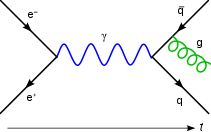Ghost (physics)
| Quantum field theory |
|---|
 |
| History |
In the terminology of quantum field theory, a ghost, ghost field, ghost particle, or gauge ghost is an unphysical state in a gauge theory. Ghosts are necessary to keep gauge invariance in theories where the local fields exceed a number of physical degrees of freedom.
For example in electrodynamics, in order to maintain manifest Lorentz invariance, one uses a four component vector potential , whereas the photon has only two polarizations. Thus, one needs a suitable mechanism in order to get rid of the unphysical degrees of freedom. Introducing fictitious fields, the ghosts, is one way of achieving this goal.
If a given theory is self-consistent by the introduction of ghosts, these states are labeled "good". Good ghosts are virtual particles that are introduced for regularization, like Faddeev–Popov ghosts. Otherwise, "bad" ghosts admit undesired non-virtual states in a theory, like Pauli–Villars ghosts that introduce particles with negative kinetic energy.
Good ghosts
Faddeev–Popov ghosts
Faddeev–Popov ghosts are extraneous anticommuting fields which are introduced to maintain the consistency of the path integral formulation. They are named after Ludvig Faddeev and Victor Popov.[2][3]
Goldstone bosons
Goldstone bosons are sometimes referred to as ghosts. Mainly, when speaking about the vanishing bosons of the spontaneous symmetry breaking of the electroweak symmetry through the Higgs mechanism. These good ghosts are artifacts of gauge fixing. The longitudinal polarization components of the W and Z bosons correspond to the Goldstone bosons of the spontaneously broken part of the electroweak symmetry SU(2)⊗U(1), which, however, are not observable. Because this symmetry is gauged, the three would-be Goldstone bosons, or ghosts, are "eaten" by the three gauge bosons (W± and Z) corresponding to the three broken generators; this gives these three gauge bosons a mass, and the associated necessary third polarization degree of freedom.[4]
Bad ghosts
"Bad ghosts" represent another, more general meaning of the word "ghost" in theoretical physics: states of negative norm,[5] or fields with the wrong sign of the kinetic term, such as Pauli–Villars ghosts, whose existence allows the probabilities to be negative thus violating unitarity.[6]
Ghost particles could obtain the symmetry or break it in gauge fields. The "good ghost" particles actually obtain the symmetry by unchanging the "gauge fixing Lagrangian" in a gauge transformation, while bad ghost particles break the symmetry by bringing in the non-abelian G-matrix which does change the symmetry, and this was the main reason to introduce the gauge covariant and contravariant derivatives.
Ghost condensate
This section has multiple issues. Please help improve it or discuss these issues on the talk page. (Learn how and when to remove these messages)
|
A ghost condensate is a speculative proposal in which a ghost, an excitation of a field with a wrong sign of the kinetic term, acquires a vacuum expectation value. This phenomenon breaks Lorentz invariance spontaneously. Around the new vacuum state, all excitations have a positive norm, and therefore the probabilities are positive definite.
We have a real scalar field φ with the following action
where a and b are positive constants and
using the sign convention in the (+, −, −, −) metric signature.
The theories of ghost condensate predict specific non-Gaussianities of the cosmic microwave background. These theories have been proposed by Nima Arkani-Hamed, Markus Luty, and others.[7]
Unfortunately, this theory allows for superluminal propagation of information in some cases and has no lower bound on its energy. This model doesn't admit a Hamiltonian formulation (the Legendre transform is multi-valued because the momentum function isn't convex) because it is acausal. Quantizing this theory leads to problems.
Landau ghost
The Landau pole is sometimes referred as the Landau ghost. Named after Lev Landau, this ghost is an inconsistency in the renormalization procedure in which there is no asymptotic freedom at large energy scales.[8]
See also
- No-ghost theorem, related to bad ghosts
References
- ^ Faddeev, Ludwig D. (2009). "Faddeev-Popov ghosts". Scholarpedia. 4 (4): 7389. Bibcode:2009SchpJ...4.7389F. doi:10.4249/scholarpedia.7389. ISSN 1941-6016.
- ^ Faddeev, Ludwig D.; Popov, Victor N. (1967). "Feynman diagrams for the Yang-Mills field". Physics Letters B. 25 (1): 29–30. Bibcode:1967PhLB...25...29F. doi:10.1016/0370-2693(67)90067-6. ISSN 0370-2693.
- ^ Chen, W.F. (2008), "Quantum Field Theory and Differential Geometry", Int. J. Geom. Methods Mod. Phys., 10 (4): 1350003, arXiv:0803.1340v2, doi:10.1142/S0219887813500035, S2CID 16651244
- ^ Griffiths, David J. (1987). Introduction to elementary particles. New York: Wiley. ISBN 0471603864. OCLC 19468842.
- ^ Hawking, Stephen W.; Hertog, Thomas (2002). "Living with Ghosts". Physical Review D. 65 (10): 103515. arXiv:hep-th/0107088. Bibcode:2002PhRvD..65j3515H. doi:10.1103/PhysRevD.65.103515. S2CID 2412236.
- ^ Itzhak Bars, John Terning. Extra Dimensions in Space and Time. p. 70.
- ^ Arkani-Hamed, Nima; Cheng, Hsin-Chia; Luty, Markus A.; Mukohyama, Shinji (2004-05-29). "Ghost Condensation and a Consistent Infrared Modification of Gravity". Journal of High Energy Physics. 2004 (5): 074. arXiv:hep-th/0312099. Bibcode:2004JHEP...05..074H. doi:10.1088/1126-6708/2004/05/074. ISSN 1029-8479. S2CID 16844964.
- ^ Daintith, John, ed. (2009). "Landau ghost". A Dictionary of Physics (6th ed.). Oxford: Oxford University Press. ISBN 9780199233991. OCLC 244417456.
External links
- Copeland, Ed; Padilla, Antonio (26 October 2011). Haran, Brady (ed.). Ghost Particles (video). Sixty Symbols. University of Nottingham.


![{\displaystyle S=\int d^{4}x\left[aX^{2}-bX\right]}](https://wikimedia.org/api/rest_v1/media/math/render/svg/a5bb1a2b5155bf9fd4f4d21caf598f6aec317a88)
